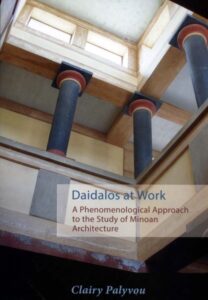ARTICLES | 2018
Grinding cereals and pulses in the Neolithic site of Kleitos: an experimental investigation of microconglomerate grinding equipment, final products and use wear
Journal of Greek Archaeology 3 (2018): 23-45
Stone grinding tools (i.e. querns or grinding stones / millstones / metates and handstones or grinders / upper milling stones / manos) constitute an important part of the material culture recovered in prehistoric excavations.Parting the waters. Middle Palaeolithic archaeology in the central Ionian Sea
Journal of Greek Archaeology 3 (2018): 1-22
This paper sets out a conceptual framework based on the idea of connectivity, and the research design that informs a series of surveys and excavations in the central Ionian Sea targeting the Palaeolithic record.The Acceptance of the Greek Solution for Linear B
Hesperia 87.1 (2018): 1-16
This article focuses on the acceptance of Michael Ventris's decipherment of Linear B as an early form of Greek and concentrates primarily on its initial reception in North America. It highlights the significant roles in the process played by two American scholars, Carl Blegen of the University of Cincinnati and Sterling Dow of Harvard University.European Bronze Age Symbols in Prehistoric Greece? Reconsidering Bronze Shields and Spears from Delphi in Their Wider Context
Hesperia 87.2 (2018): 279-309
Enigmatic objects from various sites in the eastern Mediterranean are modeled after shields that have a V-notch symbol, which are found widely across Europe. While the pieces from Greece are conventionally dated to the 8th to 7th century B.C., a recent reanalysis of one such shield from Delphi indicates that it was manufactured in the final centuries of the Bronze Age.A Cist Tomb on the South Bank of the Eridanos in the Athenian Agora and the Middle Bronze Age in Athens
Hesperia 87.2 (2018): 215-277
This article reexamines an early tomb beneath the south annex of the Stoa Basileios in the Athenian Agora and argues that it is Middle Helladic in date, rather than Submycenaean as suggested in a preliminary report. An associated deposit of Middle Helladic pottery is presented, with a detailed treatment of fabrics and shapes.Rethinking Standardization: the Social Meanings of Mycenaean Metal Cups
Oxford Journal of Archaeology 37.2 (2018): 147-163
Standardization can be conceptualized as a scale, from unique bespoke artefacts to uniform items produced on a factory line. It is usually analyzed in terms of whole objects, but is also applicable to their individual traits, such as shape, material, size, decoration or colour.The Phaistos Disk: A New Way of Viewing the Language Behind the Script
Oxford Journal of Archaeology 37.4 (2018): 373-410
This paper outlines a new linguistics‐based method of investigating the languages behind the undeciphered members of the Bronze Age Aegean family of syllabic scripts.Review of K. Aktypi, The Mycenaean Cemetery at Agios Vasileios, Chalandritsa, in Achaea (Oxford 2017)
Bryn Mawr Classical Review 2018.10.04
Aamodt, C., Review of: Κ. Aktypi, The Mycenaean Cemetery at Agios Vasileios, Chalandritsa, in Achaea (Oxford 2017), Bryn Mawr Classical Review 2018.10.04
READ THE ΒΟΟΚ REVIEW
Chalasmenos I. The Late Minoan IIIC Settlement House A.2
Philadelphia-Pennsylvania

Ornaments and Other Ambiguous Artifacts from Franchthi. Volume 1, The Palaeolithic and the Mesolithic
Indiana

Daidalos at Work. A Phenomenological Approach to the Study of Minoan Architecture
Philadelphia

Iερά και θρησκευτικές τελετουργίες στην ανακτορική και μετανακτορική μυκηναϊκή περίοδο
Athens

me-ka-ro-de. Mykenische Paläste als Dokument und Gestaltungsrahmen frühgeschichtlicher Sozialordnung
Bonn

